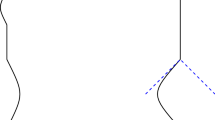Abstract
The world is described as a relativistic quantum neural net with a quantum condensation akin to superconductivity. The sole dynamical variable is an operator representing immediate causal connection. The net enjoys a quantum principle of equivalence implying local LorentzSL(2,C) invariance and causality. The past-future asymmetry of its cell is similar to that of the neutrino. A net phase transition is expected at temperatures on the order of theW mass rather than the Planck mass, and near gravitational singularities.
Similar content being viewed by others
References
Alexandroff, A. (1956). The space-time of the theory of relativity,Helvetical Physica Acta, Supplementum 4, 44–45.
Barnabei, M., Brini, A., and Rota, G.-C. (1985). On the exterior calculus of invariant theory,Journal of Algebra 96, 120–160.
Bekenstein, J. D. (1973).Physical Review D7, 2333–2346.
Bergmann, P. G. (1957). Two component spinors in general relativity,Physical Review,107, 624–629.
Bennett, C. H. (1973). Logical reversibility of computation,IBM Journal of Research and Development,6, 525–532.
Bombelli, L., Lee, J., Meyer, D., and Sorkin, R. (1987). Spacetime as a locally finite causal set, Preprint, Department of Physics, Syracuse University.
Chew, G. F., and Stapp, H. P. (1987).3-space from Quantum Mechanics, Lawrence Berkeley Laboratory, preprint LBL-23595.
De Witt, B. S. (1964)Dynamical Theory of Groups and Fields, inRelativity, Groups and Topology, C. deWitt and B. S. deWitt, eds., Gordon and Breach, Problem No. 77.
Eguchi, T., Gilkey, P. B., and Hanson, A. J. (1980). Gravitation, gauge theories and differential geometry.Physics Reports,66, 213–393.
Feynman, R. P., and Hibbs, A. R. (1965).Quantum Mechanics Via Path Integrals, McGraw-Hill, New York, Chapter 2; see also R. P. Feynman, Nobel Address.
Finkelstein, D. (1955). Internal structure of spinning particles,Physical Review,100, 924–931.
Finkelstein, D. (1958). Past-future asymmetry of the gravitational field of a point particle,Physical Review,110, 965–967.
Finkelstein, D. (1969). Space-time code,Physical Review,184, 1261–1271.
Finkelstein, D. (1987a). Coherent quantum logic,International Journal of Theoretical Physics,26, 109–129.
Finkelstein, D. (1987b). Finite physics,The Universal Turing Machine-A Half-Century Survey, R. Herken, Kammerer & Unverzagt, Hamburg.
Finkelstein, D., and Misner, C. W. (1959). New conservation laws,Annals of Physics 6, 230–243.
Finkelstein, D., and Rodriguez, E. (1986). Algebras and manifolds,Physica,18D, 197–208.
Finkelstein, S. R. (1987). Gravity in hyperspin manifolds, Ph.D. Thesis, School of Physics, Georgia Institute of Technology.
Finkelstein, S. R. (1988). Gravity in hyperspin manifolds,International Journal of Theoretical Physics, in press.
Fredkin, D., and Toffoli, T. (1982). Conservative logic,International Journal of Theoretical Physics,21, 219–253.
Hawking, S. (1975). Particle creation by black holes,Communications in Mathematical Physics,43, 199–220.
Holm, C. (1986). Christoffel formula and geodesic motion in hyperspin manifolds,International Journal of Theoretical Physics,25, 1209.
Holm, C. (1987). Hyperspin structure of Einstein universes and their neutrino spectrum, Ph. D. Thesis, Georgia Institute of Technology.
Holm, C. (1988). The hyperspin structure of unitary groups,Journal of Mathematical Physics, in press.
Kronheimer, E. H., and Penrose, R. (1965). On the structure of causal spaces,Proceedings of the Cambridge Philosophical Society 63, 481.
Kruskal, M. (1960). Maximal extension of Schwarzschild metric,Physical Review,119, 1743–1745.
Latzer, R. W. (1972). Non-directed light signals and the structure of time,Synthese,24, 236.
Misner, C. W., Thorne, K. S., and Wheeler, J. A. (1973).Gravitation, p. 1210, Freeman, San Francisco.
Peano, G. (1988).Calcolo geometrico secondo l'Ausdehnungslehre di H. Grassman, Fratelli Bocea Editori, Torino.
Penrose, R. (1965). Gravitational collapse and space-time singularities,Physical Review Letters,14, 57–59.
Penrose, R. (1971). Angular momentum: An approach to combinatorial space-time, inQuantum Theory and Beyond, T. Bastin, ed., Cambridge University Press.
Pimenov, R. (1968).Spaces of Kinematic Type (Mathematical Theory of Space-Time), Nauka, Leningrad (in Russian) [English translation,Kinematic Spaces, Consultants Bureau, New York].
Regge, T. (1961). General relativity without coordinates,Nuovo Cimento,29, 558–571.
Robb, A. A. (1936).Geometry of Space and Time, Cambridge University Press.
Ruffini, R., and Wheeler, J. A. (1970). Collapse of wave to black hole,Bulletin of the American Physical Society,15, 76.
Skyrme, T. H. R. (1961).Proceedings of the Royal Society of London A,260, 127.
Sorkin, R. (1987). Private communication. See also Bombelliet al., 1987.
Susskin, L. (1977). Lattice fermions,Physical Review D,16, 3031.
T'hooft, G. (1979). Quantum Gravity: A Fundamental Problem and some Radical Ideas, inRecent Developments in Gravitation. Cargese 1978, M. Lévy and S. Deser, eds., Plenum, New York.
Weinberg, S. (1984). Quasi-Riemannian theories of gravitation in more than four dimensions,Physics Letters,138B, 47–51.
Von Weizsäcker, C. F. (1955).Komplementarität und Logik Naturwissenschaften,19, 548.
Von Weizsäcker, C. F. (1985).Aufbau der Physik, Hanser, Munich.
Zeeman, C. Causality implies the Lorentz group.Journal of Mathematical Physics 5, 490–493.
Żenczykowski, P. (1988). Combinatorial descriptions of space and strong interactions,International Journal of Theoretical Physics,27, 9.
Author information
Authors and Affiliations
Rights and permissions
About this article
Cite this article
Finkelstein, D. “Superconducting” causal nets. Int J Theor Phys 27, 473–519 (1988). https://doi.org/10.1007/BF00669395
Received:
Issue Date:
DOI: https://doi.org/10.1007/BF00669395




